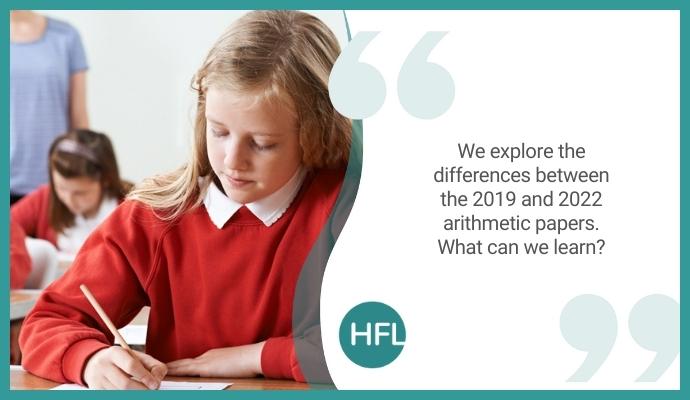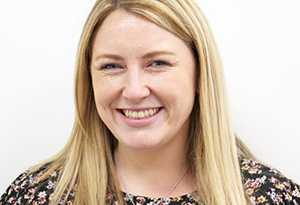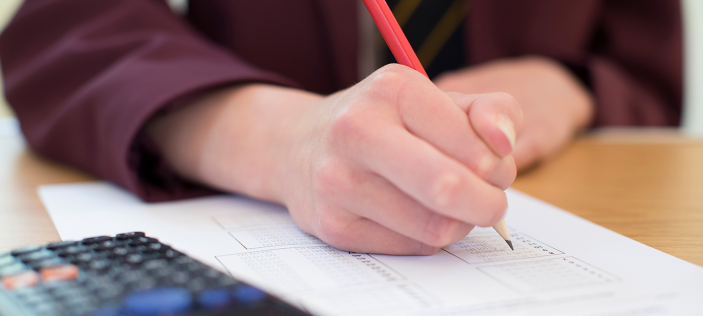
I don’t think that we can write a blog series about the 2022 KS2 SATs without firstly acknowledging the disruption to the last 3 years of education which has been vast and varied. However, no matter whether you agree or disagree that the assessments took place this year, the fact is that they did. So, what can we learn from them?
In our first blog in the series, we explored the similarities between the 2022 and previous arithmetic papers with particular comparisons to 2019. In this blog, we will switch our focus to the differences. Finally, in the third blog of the series we will consider the reasoning papers.
I also think that it is really important to remind ourselves that this blog is not just for Year 6 teachers – this is a KS2 assessment at the end of the children’s primary school journey and so all teachers are involved!
Quick domain and year group comparison
Before we dive into key differences we have noted as a maths team, let us just touch on some of the similarities between the 2019 and 2022 arithmetic papers in terms of the domain and year group coverage as shown in the mark schemes.
As detailed in the first blog, the domain coverage remains much the same with the majority of marks shared between calculations and fractions, decimals and percentages (although as detailed in the previous blog, we should note the ‘hidden’ importance of place value understanding). With regards to year group coverage, the picture looks roughly the same across the two years as shown in the tables below:
In these tables, the primary reference from the mark schemes has been used. The total of 40 refers to the number of marks in the paper with the four 2-mark questions being attributed to Year 6 calculations.
These are referenced in the mark scheme as 6C7a (multiply multi-digit numbers up to 4 digits by a two-digit whole number using the formal written method of long multiplication) and 6C7b (divide numbers up to 4 digits by a two digit whole number using the formal written method of long division, and interpret remainders as whole number remainders, fractions, or by rounding, as appropriate for the context).
It is useful to note these similarities as it may be assumed that the types of questions asked will be largely the same which is fair to say, and it could be argued that the paper follows a very similar procedure in terms of the writing but in this blog, we will explore some of the more subtle differences and consider their implications.
A tricky opener?
Let’s start at the beginning with the very first question. Historically, the first question, or perhaps the first few questions, have been relatively comfortable for many of the children to access with questions such as:
Here is this year’s (2022) question which could be argued is a fairly tricky opener:
How do you do yours?
How did your children tackle this? I wonder how many children may have relied on a formal written method here but made the following errors:
- lined up the place value columns incorrectly given that one number is 4-digit and the other two are 3-digit?
- lined the columns up correctly however when calculating, made errors when adding three 1-digit numbers?
- or made calculating errors when needing to deal with the regroups required in the ones, tens and hundreds columns?
It would be interesting to use similar questions with classes this year to explore the calculation strategies that the children are choosing to use.
When adding 5 ones, 1 one and 9 ones, do they recognise the complements to 10 and then add 5 more?
Or perhaps when adding 5 tens, 0 tens and 4 tens, do they notice that this could be calculated by doubling 4 tens and adding 1 more ten (and then the regrouped ten from the ones column of course)?
Or perhaps they recognise that if adding the two 3-digit numbers, this could be rebalanced from 501 + 649 to 500 + 650; subtracting 1 from 501 and adding 1 to 649 to keep the sum equal.
1,150 could then be added to 6,155 – perhaps with the children rebalancing again to 1,100 and 6,205 by adding and subtracting 5 tens.
Some questions to consider could be:
- are the children over reliant on formal written methods and if so, do they use these accurately?
- do children have a ‘toolkit’ of strategies and choose these appropriately depending on the numbers at hand?
- is this ‘toolkit’ of strategies built up across the primary phase and revisited often so that children are confident with strategies?
- how often are children given opportunities to use multiple strategies to solve a calculation and then assess efficient and inefficient methods?
- how fluently can children add and subtract 1-digit numbers? Might strategies such as complements to 10, think or make 10, rebalancing, and doubles and near doubles be worth revisiting?
Equal shmequal?
The next difference worth noting is around the concept of the equals sign. As we know from much of our work with teachers and children, when the equals sign is in a less familiar position – perhaps the start of the calculation rather than the end – that this can cause problems.
Why?
Because the children don’t have a secure understanding of the role of the equals sign and what it actually means.
Having said this, in 2019, the QLA (question level analysis) recorded that the questions above had an average correct response rate of 94% and 93% so not only did the children cope with the fact that the equals sign is at the start of the calculation, they had accurate methods to solve the calculations. It may well be worth comparing how this year’s cohort got on with the following 2 questions:
Arguably, the calculations needed here should be well within in the grasp of Year 6 children, using their place value knowledge and base facts to solve question 7 and then perhaps a formal method of short multiplication for question 15 (Year 4 content). The shift here is to understanding the role of the equals sign and tackling the division and multiplication calculations which may be operations that children feel less confident with.
If some children are unsure about the role of the equals sign, perhaps only seeing it as meaning ‘the answer’, it would be worth specific exploration of this using equipment such as pan balances and Cuisenaire rods.
For example, start with a fact that the children are confident with and a question such as …… = 2 + 5 and allow children to explore using the rods. Which rod is needed to balance the scales?
Recordings or descriptions could be in the form of:
- 7 = 2 + 5
- 7 is the same as 2 + 5 or
- 7 is equivalent to 2 + 5.
This could then be extended to ….. = 2 x 5 with the children placing 2 lots of the rod worth 5 in one side of the balance and then finding the rod or rods that will balance the scales. …… = 2 x 5 can then be recorded as: 10 = 2 x 5 and 10 is equal to 2 groups of 5 etc.
Once this understanding is secure, this could be extended to division; again using facts that the children are familiar with.
It is often very useful for the children to rehearse saying aloud the calculation and using the word ‘something’ in place of an ‘answer’ box or missing number. For example,
‘Something is equal to 240 divided by 8 so 240 divided by 8 is equal to something’.
Some questions to consider could be:
- how secure is the children’s understanding of the equals sign? Do they have the misconception that = means ‘the answer’ or can they articulate that = means equivalent, the same as or draw comparisons with a balance?
- did most of the children attempt these questions or were they put off by the fact that they involve multiplication and division?
- would the children cope better with these questions had they involved addition and subtraction and if so, what does this mean about the rehearsal time provided for the children across Key Stage 2?
Of zero importance
What do each of the following calculations have in common?
Those of you who know the papers well may have noticed that these are three of the 2-mark questions. But our focus here is that all of these questions involve 0 as a place holder - another subtle shift in difficulty.
0 is hard to deal with, especially when found within more complex multiplication and division calculations.
These questions aren’t the only ones that involve 0.
I wonder how many children had the age-old common misconception that 0 x 989 = 989.
If children made these same mistakes in questions 19 and 33, this would cause more than one calculation error and loss of both marks, even if using the formal method.
Throughout questions 19 and 33, the children need to deal with place holders, not only when they are multiplying by the ones and then tens, but also remembering that when multiplying by the 8 tens for example, that this is 8 tens and not 8 ones and so although 8 x 7 = 56 is a useful base fact, it is actually 80 x 7 = 420.
How many times do we see children omitting the 0 when multiplying by the tens digit and not truly thinking about the place value? Often it is the children who may remember the process – multiply by the 3 then multiply by the 8 – who do not have secure understanding when multiplying by the tens digit.
The zero is perhaps less problematic in the dividend in question 29. However, when subtracting 292 (4 groups of 73) from 306, hopefully the children do not swap the digits around to 9 – 0 and instead see that it is 30 hundreds subtract 29 hundreds leaving 1 hundred.
What may be trickier is that children will need to consider the fact that they need to firstly regroup 3 thousands into 30 hundreds, and then 306 tens before then dividing this by 73. Do they record these place holders at the start of their quotient to help them to keep track that 306 tens divided by 73 is 4 with 14 tens remaining?
Some questions to consider could be:
- do children really understand the effect of multiplying by 0? Can they demonstrate with drawings or models how 0 multiplied by any number will always result in the product of 0 by comparing this to multiplying by 1. For example, do they say ‘1 group of 989 is 989 so 0 groups, or no groups of 989 is 0 or nothing!’
- are children secure when multiplying by tens and hundreds digits? Are they able to articulate that it is 8 tens multiplied by 7 ones and 8 tens multiplied by 6 hundreds for example.
- are children given opportunities to deal with place holders in different positions in complex multiplication and division calculations? For example, are they presented in divisors and dividends? Are they needed in different positions in the quotients? Are questions written carefully so that all of these opportunities arise?
The only way is long division…
Let’s turn our attention to long division as our final difference.
In the mark scheme, children are able to gain a mark if they use the formal methods of either short or long division to solve appropriate questions – in the case of 2022, this is for questions 17 and 29.
Children are often encouraged to use these methods for these types of calculations as the mark scheme states that, ‘If the answer is incorrect, award ONE mark for the formal method of division with no more than ONE arithmetic error’.
Those of you who have had a lot of experience with the KS2 assessments are likely to know that in the past, all divisors (the number that we are dividing by) used for the 2-mark division questions have been prime numbers.
For example, divisors in the past have been 23 and 97 (2018) and 37 and 83 (2019).
However, this year, the divisor of 21 was used in question 17 – a composite number.
This opens the potential to solve this calculation using knowledge of factors and so potentially making this a more manageable calculation.
- if dividing 672 by 3 first, both 6 hundreds and 72 tens are divisible by 3 perhaps using base facts or knowledge of the distributive law?
For example, regrouping 72 into 60 and 12. 672 divided by 3 is 224 which could then be divided by 7 (3 x 7 = 21 – the divisor) to give 32.
- if dividing by 7 first, 67 tens divided by 7 is a manageable calculation using the knowledge that 63 divided by 7 is 9. This would then leave a remaining 42 ones which is a multiple of 7.
672 divided by 7 is 96 which can then be divided by 3 to give 32.
In the examples above, you will see that formal methods of division have still been used as a step in solving the original calculation, but these have been simplified by working with the individual factors in turn as divisors instead of 21.
To caveat this, had the children used a method other than a formal method of division and made 1 calculation error, they would not have been awarded a mark for their working out.
It could also be argued that using long division for this calculation (21 is quite a friendly number to multiply after all) using the factors complicates the method.
However, this question nicely highlights that multiple strategies could be used to reach the answer and their efficiency may change from child to child.
It also highlights that when children are rehearsing division methods, all methods should be explored and celebrated. In fact, for those who are very fluent with methods for division, having a formal method banned in a lesson could be more challenging and encourage flexibility and creativity.
Of course, when time is pressured, such as in the actual sitting of SATs papers or using them as a formal practice in readiness, children should be encouraged to use their most efficient and accurate methods.
Some questions to consider could be:
- what does the progression of division methods look like across key stage 1 and key stage 2 in your school?
- are children given opportunities to solve calculations in multiple ways and are calculations written to allow multiple methods e.g., using a prime number as a divisor?
- are different calculation methods shared and celebrated?
As mentioned in the previous blog, this series of blogs has been written before the QLA (question level analysis) is available and so it will be interesting to compare how your children did against national data especially where there has been a change in the way questions have been presented and subtle shifts in complexity.
If you have a chance to have a look at your data, you may want to use the ‘questions to consider’ throughout both blogs to consider implications for teaching and rehearsal, such as:
- checking foundational understanding by tracking back to simpler examples and
- ensuring variation in the types and presentation of questions that children are exposed to and explore.
Year 6 SATs analysis toolkit
The ‘Year 6 SATs analysis toolkit’ provides teachers and subject leaders with a suite of resources and analysis tools to identify specific areas of learning strength and development for pupils and classes when using any past SATs papers as practice (2016-2022).
Accompanying the analysis spreadsheets, documents and progress tracker is a digital guidance video that explains each of the resources and how to use them.
Included with HfL PA Plus subscription and available to purchase from:
Mathematics - Year 6 SATs analysis toolkit
References
- Mathematics test framework: National curriculum tests from 2016 for test developers
- 2017 Key Stage 2 mathematics paper 1: arithmetic
- 2018 Key Stage 2 mathematics paper 1: arithmetic
- 2019 Key Stage 2 mathematics paper 1: arithmetic
- 2022 Key Stage 2 mathematics paper 1: arithmetic
- 2022 Key stage 2 mathematics test mark schemes
Contains material developed by the Standards and Testing Agency for 2016, 2017, 2018, 2019 and 2022 national curriculum assessments and licensed under Open Government Licence v3.0.

-exploring-the-differences-2.JPG)
-exploring-the-differences-3.JPG)
-exploring-the-differences-4.JPG)
-exploring-the-differences-5.JPG)
-exploring-the-differences-6.JPG)
-exploring-the-differences-7.JPG)
-exploring-the-differences-8.JPG)
-exploring-the-differences-9.JPG)
-exploring-the-differences-10.JPG)
-exploring-the-differences-11.JPG)



